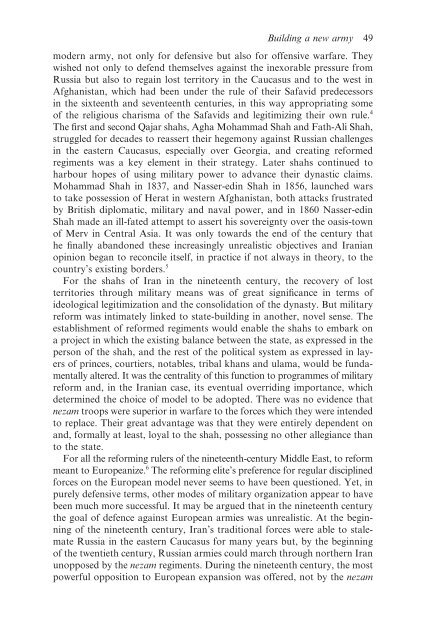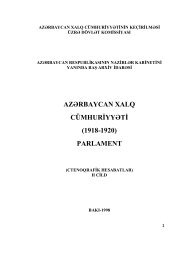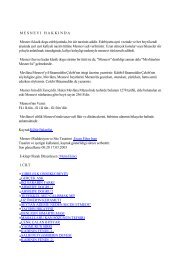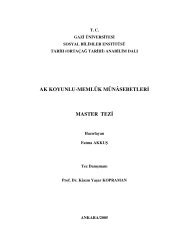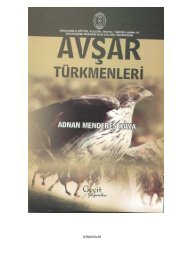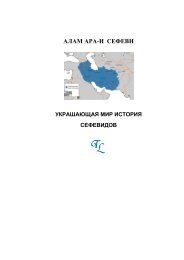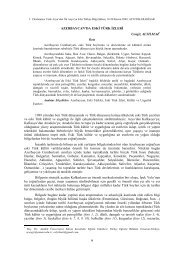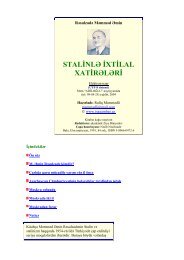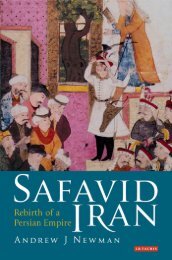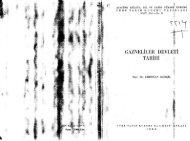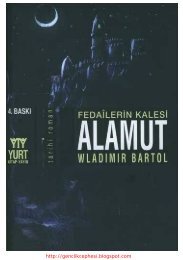War and Peace in Qajar Persia: Implications Past and ... - Oguzlar.az
War and Peace in Qajar Persia: Implications Past and ... - Oguzlar.az
War and Peace in Qajar Persia: Implications Past and ... - Oguzlar.az
- No tags were found...
You also want an ePaper? Increase the reach of your titles
YUMPU automatically turns print PDFs into web optimized ePapers that Google loves.
Build<strong>in</strong>g a new army 49modern army, not only for defensive but also for offensive warfare. Theywished not only to defend themselves aga<strong>in</strong>st the <strong>in</strong>exorable pressure fromRussia but also to rega<strong>in</strong> lost territory <strong>in</strong> the Caucasus <strong>and</strong> to the west <strong>in</strong>Afghanistan, which had been under the rule of their Safavid predecessors<strong>in</strong> the sixteenth <strong>and</strong> seventeenth centuries, <strong>in</strong> this way appropriat<strong>in</strong>g someof the religious charisma of the Safavids <strong>and</strong> legitimiz<strong>in</strong>g their own rule. 4The first <strong>and</strong> second <strong>Qajar</strong> shahs, Agha Mohammad Shah <strong>and</strong> Fath-Ali Shah,struggled for decades to reassert their hegemony aga<strong>in</strong>st Russian challenges<strong>in</strong> the eastern Caucasus, especially over Georgia, <strong>and</strong> creat<strong>in</strong>g reformedregiments was a key element <strong>in</strong> their strategy. Later shahs cont<strong>in</strong>ued toharbour hopes of us<strong>in</strong>g military power to advance their dynastic claims.Mohammad Shah <strong>in</strong> 1837, <strong>and</strong> Nasser-ed<strong>in</strong> Shah <strong>in</strong> 1856, launched warsto take possession of Herat <strong>in</strong> western Afghanistan, both attacks frustratedby British diplomatic, military <strong>and</strong> naval power, <strong>and</strong> <strong>in</strong> 1860 Nasser-ed<strong>in</strong>Shah made an ill-fated attempt to assert his sovereignty over the oasis-townof Merv <strong>in</strong> Central Asia. It was only towards the end of the century thathe f<strong>in</strong>ally ab<strong>and</strong>oned these <strong>in</strong>creas<strong>in</strong>gly unrealistic objectives <strong>and</strong> Iranianop<strong>in</strong>ion began to reconcile itself, <strong>in</strong> practice if not always <strong>in</strong> theory, to thecountry’s exist<strong>in</strong>g borders. 5For the shahs of Iran <strong>in</strong> the n<strong>in</strong>eteenth century, the recovery of lostterritories through military means was of great significance <strong>in</strong> terms ofideological legitimization <strong>and</strong> the consolidation of the dynasty. But militaryreform was <strong>in</strong>timately l<strong>in</strong>ked to state-build<strong>in</strong>g <strong>in</strong> another, novel sense. Theestablishment of reformed regiments would enable the shahs to embark ona project <strong>in</strong> which the exist<strong>in</strong>g balance between the state, as expressed <strong>in</strong> theperson of the shah, <strong>and</strong> the rest of the political system as expressed <strong>in</strong> layersof pr<strong>in</strong>ces, courtiers, notables, tribal khans <strong>and</strong> ulama, would be fundamentallyaltered. It was the centrality of this function to programmes of militaryreform <strong>and</strong>, <strong>in</strong> the Iranian case, its eventual overrid<strong>in</strong>g importance, whichdeterm<strong>in</strong>ed the choice of model to be adopted. There was no evidence thatnezam troops were superior <strong>in</strong> warfare to the forces which they were <strong>in</strong>tendedto replace. Their great advantage was that they were entirely dependent on<strong>and</strong>, formally at least, loyal to the shah, possess<strong>in</strong>g no other allegiance thanto the state.For all the reform<strong>in</strong>g rulers of the n<strong>in</strong>eteenth-century Middle East, to reformmeant to Europeanize. 6 The reform<strong>in</strong>g elite’s preference for regular discipl<strong>in</strong>edforces on the European model never seems to have been questioned. Yet, <strong>in</strong>purely defensive terms, other modes of military organization appear to havebeen much more successful. It may be argued that <strong>in</strong> the n<strong>in</strong>eteenth centurythe goal of defence aga<strong>in</strong>st European armies was unrealistic. At the beg<strong>in</strong>n<strong>in</strong>gof the n<strong>in</strong>eteenth century, Iran’s traditional forces were able to stalemateRussia <strong>in</strong> the eastern Caucasus for many years but, by the beg<strong>in</strong>n<strong>in</strong>gof the twentieth century, Russian armies could march through northern Iranunopposed by the nezam regiments. Dur<strong>in</strong>g the n<strong>in</strong>eteenth century, the mostpowerful opposition to European expansion was offered, not by the nezam


